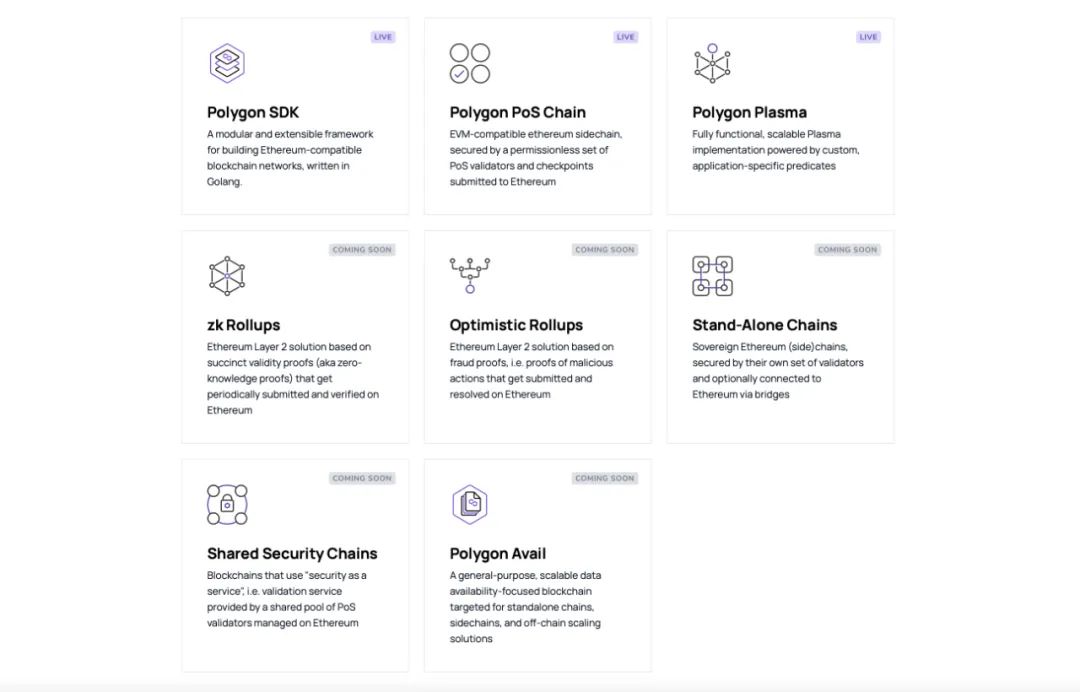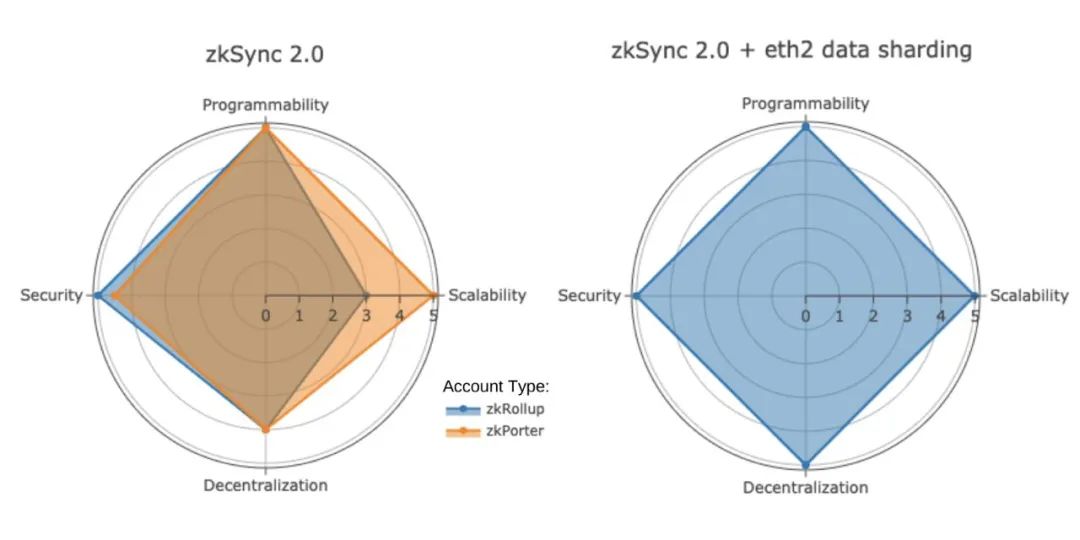The acquisition of Hermez makes Polygon the most comprehensive scaling solution. How will other L2s respond?
Written by: Pan Zhixiong
Polygon's acquisition of Hermez for $250 million may be the second-largest merger of a blockchain-native protocol to date. The Ethereum scaling solution Polygon has thus completed the most challenging scaling technology based on zero-knowledge proofs (ZK), bringing them one step closer to their envisioned "full-stack" scaling solution.
Since Polygon provides a variety of solutions in the Ethereum scaling space, the team has likened themselves to a "Swiss Army knife of Ethereum scaling." This includes the core Polygon PoS chain, two mature solutions Polygon SDK and Polygon Plasma, as well as the recently unveiled Polygon Avail, which aims to build a dedicated data availability layer.
The addition of Hermez further enhances Polygon's Rollup solutions, specifically with the direct implementation of ZK Rollup technology.
The Hermez team was previously the development team behind the decentralized identity system iden3, where they gradually conceived the idea of exploring ZK Rollup scaling solutions during the development of the identity system, having previously received support from the Ethereum Foundation.
With the completion of this merger, StarkWare and zkSync have become some of the few competitors capable of challenging Polygon in providing a full suite of scaling solutions. Both teams offer two tiers of solutions, allowing users to choose between "lower cost" and "greater security." It remains unclear whether the Optimistic Rollup solutions Arbitrum and Optimism will attempt to explore lower-cost solutions beyond Rollup, as the scaling efficiency of Rollup has its limits unless Ethereum can truly deploy sharding technology.
1. The First Comprehensive Merger of Blockchain Networks?
In March of this year, the teams behind the privacy-focused blockchain protocols Keep Network and NuCypher chose to merge their networks, which is now referred to as KEANU. This is also the first time the concept of a merger has been proposed in the cryptocurrency industry, prompting both parties to conduct governance and voting within their respective communities to gradually advance the merger.
Keep Network is a project under the Thesis company, whose privacy protocol layer has been used to develop the cross-chain protocol for Bitcoin assets, tBTC. Keep Network was originally intended to provide a privacy layer for Ethereum, utilizing off-chain containers to store private data, while tBTC leverages the KEEP token and its multi-signature mechanism.
NuCypher, on the other hand, focuses on fully homomorphic encryption (FHE) technology, providing a code library that allows external nodes to perform secure and private computations on encrypted data.
After proposing the merger concept, both parties gradually advanced the specific details of the merger over the following months. The new token launched by both parties is called T, with a total supply of 10 billion, where NU and KEEP token holders can each receive 45%, with the remainder allocated to the KEANU DAO for community governance. The development teams of both parties will remain independent.
In contrast, while Polygon and Hermez are merging tokens, it is essentially a acquisition. Hermez's HEZ will be absorbed into the Polygon network and will ultimately be exchanged for MATIC tokens, leading the Polygon team to state: "To our knowledge, this is the first comprehensive merger of blockchain networks."
2. How Do Polygon and Hermez Merge?
For blockchain protocols, a merger involves at least three components: tokens, teams, and technology.
Since Polygon is fully acquiring Hermez, there will only be one token, MATIC, in the Polygon ecosystem. Hermez's HEZ can be exchanged for MATIC at a fixed rate of 1 HEZ = 3.5 MATIC. The HEZ token will become unusable after a specific date in the future, with details to be announced gradually.
The ZK Rollup layer 2 network previously launched by Hermez will be renamed Polygon Hermez, and the governance token will change to MATIC instead of HEZ. All components of the Hermez project will be fully integrated into the Polygon ecosystem, including technology, deployed solutions, teams, etc.
Hermez's Core Technology: zkEVM
Hermez originated from the decentralized identity system iden3 team within the Ethereum ecosystem, which initially aimed to apply ZK Rollup technology to high-frequency scenarios such as identity verification. As the technology evolved, they planned to gradually upgrade this specific scenario solution into a general solution compatible with EVM based on zero-knowledge proof technology, known as zkEVM. Prior to this, Hermez's layer 2 network, which officially launched in March of this year, only supported transfers in this specific scenario.
iden3 also developed the zkSNARKS circuit compiler Circom, a tool used by many teams related to zero-knowledge proofs, which has also received support from the Ethereum Foundation.
At last month's EthCC 4 Ethereum community conference, the Hermez team officially unveiled the zkEVM solution. Unlike other zkEVM teams, they aim to implement all EVM opcodes through zero-knowledge proof circuits. Currently, teams exploring zkEVM include the zkEVM team established by the Ethereum Foundation and the zkSync team.

The Hermez team stated that they will conduct a proof of concept for zkEVM this quarter, deploy a testnet in the fourth quarter, and launch the mainnet in the second quarter of next year. Based on this timeline, zkSync's zkEVM solution may be implemented before the Hermez team.
3. Does Polygon Have 4 Scaling Solutions? Far More Than That
After announcing the acquisition of the Hermez team, Polygon released a screenshot in the community listing their four scaling solutions: Polygon SDK, Polygon PoS, Polygon Avail, and Polygon Hermez.

However, according to their official website, they have many more scaling solutions in the planning stages. The solutions listed in the image are likely their four most important ones:
- Polygon PoS is currently the most widely used sidechain scaling network in the Ethereum community, sometimes simply referred to as Polygon;
- Polygon SDK is a modular and extensible framework for Ethereum-compatible blockchain networks;
- Polygon Avail is a data availability solution within a scaling solution, belonging to one of the newer technological routes;
- Polygon Hermez is a scaling solution based on ZK Rollup technology, which is currently live;
In addition, Polygon plans to launch three new solutions: Optimistic Rollup solutions, independent blockchain solutions, shared security chains, and a scaling solution Polygon Plasma that has already launched but is gradually being abandoned by the community.

Through these solutions, Polygon can cover a variety of scaling solutions with different data availability, security, and costs, ensuring that there is something suitable for different users.
4. Is Polygon Avail Accused of Plagiarism?
Recently, after Polygon announced the launch of the general scalable data availability layer solution Avail, Celestia (formerly known as LazyLedger) co-founder Mustafa Al-Bassam claimed on social media that the introduction of Polygon Avail was almost a verbatim copy of his 2019 article introducing LazyLedger.
LazyLedger is an innovative scaling direction that builds an independent data availability layer, allowing anyone to quickly deploy decentralized blockchains without worrying about how to start a consensus network. However, it is still in the early stages, and the team has made their progress public on GitHub, indicating that there is still a long way to go before the mainnet launch.

In response to Mustafa Al-Bassam's accusations of plagiarism regarding Polygon Avail, the Polygon team stated that the similarities in the introduction text were a mistake by the marketing and content teams. In reality, Avail and Celestia are two different architectures, with the main difference being that Avail is based on Kate commitments, while Celestia is based on fraud proofs. Therefore, there are substantial technical differences, but they still apologized to Celestia and its community for the marketing and content team's mistake.
Whether the technology is plagiarized indeed requires professional judgment, and everyone's standards may differ. While the open community of blockchain is relatively tolerant of code borrowing (Fork), people still prefer to support more innovative and original teams, which some refer to as "authenticity."
Although the Polygon team's statement regarding the marketing content plagiarism of Avail temporarily resolved this controversy, for Polygon, perhaps only by quickly bringing the Avail product to fruition can they completely "prove their innocence."
5. Who Else Can Provide Full-Stack Solutions?
While no team can launch as many scaling solutions as Polygon, the ZK Rollup teams StarkWare and Matter Labs in the Ethereum community can also provide at least two solutions for users, allowing them to choose between "lower cost" and "greater security."
StarkWare has long launched a scaling solution based on StarkEx technology, with dYdX being one of the most typical applications. This solution does not place data availability on the Ethereum blockchain, making it comparatively lower in cost, although it may slightly reduce security compared to another solution.
StarkWare plans to launch the StarkNet scaling solution by the end of this year, which can support placing data availability within Ethereum blocks. This type of solution will be more expensive than StarkEx, but its security can be considered almost equivalent to that of the Ethereum mainnet.
Matter Labs' upcoming zkSync 2.0 also follows this structure, although its technical implementation differs from StarkWare. The zkSync account can provide security equivalent to the Ethereum mainnet, with slightly higher costs, while the zkPorter account can offer extremely low transaction costs.

Currently, both Arbitrum and Optimism only support one type of scaling solution, which is the Optimistic Rollup solution. They have chosen to place data availability within Ethereum blocks and ensure the security of the layer 2 network through fraud proofs.
Although Arbitrum and Optimism may be the fastest general Rollup scaling solutions to launch in the coming months, they currently do not support lower-cost scaling solutions, which may put them at a disadvantage following Polygon's acquisition. It remains unclear whether they will consider acquiring or developing a lower-cost scaling solution to meet more users' needs, or if Optimism has an easier option, which is to revive their Plasma solution from their time as the Plasma Group, placing data availability off-chain, similar to zkPorter and StarkEx.
Especially after the explosion of multi-scenario applications in gaming and DeFi, user demands are highly diverse, and perhaps no single solution will satisfy all users.









